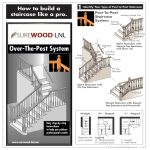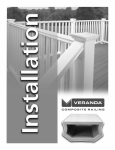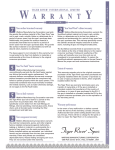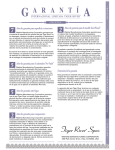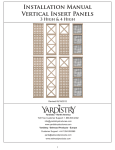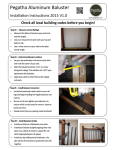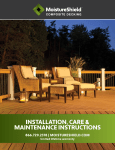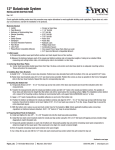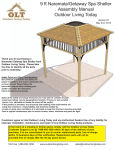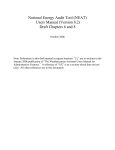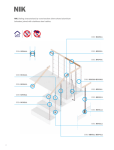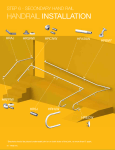Download Stair Parts 4095P-056-0000L Installation Guide
Transcript
How to build a staircase like a pro. 1 Identify Your Type of Post-to-Post Staircase: Post-To-Post Staircase System Starting Landing Newel Post Newel Post SUREWOOD LNL Square Top Balusters ~ Shoerail Open Staircase with Square Top Balusters and Shoerail Wall Rail Level Run Handrail Rake Handrail Rosette Pin Top Balusters Open Staircase with Pin Top Balusters Kneewall Closed Staircase with Square Top Balusters and Kneewall Straight SOM300113 Effective 11/20/2006 Determine the parts needed. “U” - Shaped Legend A - Starting Newel B - Landing Newel “L” - Shaped C - Rosette D - Half Newel 2 Selecting Your Parts: 3 Post-to-Post Staircase Parts Checklist: There are several styles and options for your treads, risers, balusters and newel posts. Below are the most common. Other items are available by special order. Check with your store representative. Check local building codes to ensure compliance. All stair parts shown in this brochure are for interior use only. Treads - Select one tread for each step. Part number Quantity Selected Needed _______ _______ Balusters, Newel Posts, Handrails, and Shoerails: Risers - Select one riser for each step. Select one more riser than treads per each staircase. _______ _______ Landing Tread - Select sufficient lineal footage for the entire balcony and width of stairs at each landing. _______ _______ Return Nosing - If stair is open on one side, select one tread return nosing per step. If two-sided, select two per step. _______ _______ Starting Newel* - Use at the bottom of the staircase. _______ _______ Landing Newel* - Use at the landing corner of an L-shaped stair and at the second floor landing. _______ _______ Pin Top Baluster: Square Top Baluster: Pin top balusters used with solid handrail. 6010-S Solid handrail 6010-P Plowed handrail A 6050 Fillet 1-1/4’’ B 6045 Shoerail 1-1/4’’ A Level Run Newel* - If the balcony is 10 feet or longer, use a newel every 5 or 6 feet. Place a newel at every corner. The Landing Newel may be used, but be sure to match the top block with the newel used at the top of the stairway for consistency. _______ _______ B Starting Newel 48’’ Starting Newel 54’’ Landing Pin Top Square Starting Top Newel Baluster Newel Baluster 59’’ 48’’ Treads and Risers: Newel Mounting Hardware (J-Anchor) - Select one newel _______ _______ mounting kit for each newel post mounted on top of a tread. 3503-BT 3500-BT54 3500-BT 5205 5015 4015-BT 4012-BT* 4010-BT Rosette or Half Newel - Select either a rosette or half newel _______ _______ for each handrail connecting to a wall. Starting Newel 54’’ Landing Newel 54’’ Wall Rails and Handrail Ends: SUREWOOD LNL ~ Tread 6042 Wall Rail Riser 7009 7011 Returned End Quarterturn Wall Rail Brackets: 8080 Tread Return Nosing C Rosettes: 8090 Landing Tread Mounting Hardware: Rail Bolt J-Anchor with molding Wood Plugs D Half Newel: Round Rosette Oval Rosette For Wall Finishing Half newels available to match newel style. Rake Balusters* - Select the 34“ baluster for the front baluster on each tread and the 36“ baluster for the back baluster on each tread. If using 3 balusters per tread, use the 36“ baluster for the middle baluster on each tread. _______ _______ Rake Balusters for Kneewall Staircase* - Select the 34“ baluster at a rate of 2 per tread. Standard placement is 4”on center. Check local building code for your area. _______ _______ Level Run Balusters* - Use the 36“ baluster for all 36“ height balconies and the 41“ baluster for all 41“ height balconies. Standard placement is 4”on center. Check local building code for _______ _______ your area. Handrail - Buy 13“ of handrail for each tread or step. Buy enough for all level runs. _______ _______ Shoerail for Rake - Buy 13” of corresponding shoerail for each tread or step (shoerail or kneewall stairs only). _______ _______ Shoerail for Balcony (optional) - Buy enough to cover all Level Runs. _______ _______ Plugs -Select two wood plugs for every newel mounting using lag bolts. Select one plug for each handrail rail bolt used. Select one plug for every handrail or shoerail mounting using a lag _______ _______ bolt or wood screw. *Note: These guidelines are for a rake handrail height of 36“– 41“. Longer newels and balusters may be required for a different handrail height. 4 6 Tools Required: Operation: Tools Needed: Measuring and Leveling Metal measuring tape, hand levels, (torpedo and 4’ level), framing square Cutting Miter box and saw (fine-tooth) hand or power circular saw or standard hand saw Nailing Hammer, nail set, 1/2“ and 1“ finishing nails Gluing Carpenter’s glue and construction adhesive Screw Driving Screwdriver (manual or power), 3“ wood screws Drilling Hand drill, drill guide and 1/8“, 1/4“, 3/8“, 5/8“, 3/4“, 1“ wood bits Finishing Sandpaper, steel wool, wood file, wood chisel, finishing stain, rags, tack cloth, etc. 5 Basic Layout and Newel Post Installation: Landing Newel Height A) Height of the handrail should be between 36“ and 42”. Check local building codes. B) Place the top of the handrail one inch below the top block of the newel. Tread Return Nosing With newel in position where it is to be mounted, slide short end of framing square along slope of stairway. Baluster B) Measure down 1” from Centerline top of newel square. Make Face of Stringer mark. Mark Position of Baluster Centerpoint C) The difference between Starting Newel the two marks “A”and “B” is what will be cut off bottom of newel. Proceed with newel installation. Landing Tread Landing Tread A B 1’’ from top of square part of newel 36’’ to 42’’ above front of tread Check local building codes for proper handrail height. Newel Post Attachment Trim and Fasten the Newel Posts Tread Tread Return Nosing Installation Cut and miter tread return nosing to fit. Adds a finished look to the tread edge. Tread Return Nosing B C A) Slide into post as shown. Make mark. B Landing tread can be used with 3/4”oak flooring along a landing when solid oak treads and risers are used. Landing tread can be used along a balcony with oak flooring. Properly cut miters and attach directly to sub floor. A Mark Position of Landing Newel and Centerline To properly install solid oak treads and risers, you must first remove the existing steps to expose the rough framing. Leave the beginning riser at base of steps (A). Measure and cut each step separately to ensure tight fit. (B). Pre-drill, apply construction adhesive and nail into place. For added strength, screw treads to risers from behind (C). Complete each step before continuing on to next step. C 1’’ Layout your staircase directly on your treads and landings. Carefully mark Newel and Baluster positions and centerlines. Getting Started - Tread and Riser Installation: A Starting Newel Height Marking Your Staircase for Installation J-Anchor with Molding Wood Plugs Lag Bolts 7a Attaching Handrail for Pin Top Balusters: Pin top are installed first on the staircase and then the handrail is lowered down onto them. 7b Attaching Handrail for Square Top Balusters: Square top balusters are installed after the bottom shoerail and plowed handrail are installed. A) Mark baluster placement on treads allowing for equal spacing. Drill treads the same size and depth as pin on bottom of baluster. Mark and Cut Here A A) Lay handrail and shoerail along stairs, marking where they intersect with newels. Place rail on side and cut along marks. A B) Attach handrail using option #1 (3”wood screws) or option #2 (4-1/2” lag bolts through front of rail). Both options require pre-drilling a pilot hole. Attach shoerail using option #1 (3”wood screws), option #2 (toe-nailed finishing nails) or option #3 (screwed to kneewall). Handrail B) Lay handrail along stairs allowing extra length for proper fit to newels. Using framing square, transfer tread markings to side of handrail. Transfer markings to bottom center of handrail. B Shoerail B 1 C) Locate baluster holes in solid handrail. Mark center of handrail C Mark Handrail Here D) Rotate handrail 180 ° on stairs so balcony side of handrail is at base of stairs. Drill holes using 5/8” drill bit a minimum of 3/4”deep into handrail. Use drill guide set to proper angle E) Using newels as guide, mark handrail and cut to proper length. Follow instructions for attaching newels. BALCONY Mark and Cut Here Lag Bolt Wood Screws C For balconies, follow same procedures, keeping handrail on flat surface when drilling. Countersunk Wood Screws 2 Wood Plug C) Use an D adjustable square to determine the angle of the cut; allow for 1/4” plow depth on each handrail and shoerail. Wood Plug Toe-nailed Finishing Nails Screwed to Kneewall 3 2 1 D) Cut E balusters to the correct length.Once spacing is determined, glue and toenail balusters into place. E )Cut fillet pieces being sure to match angles. Glue and nail into place using 1/2” finishing nails. *Most codes require 4”on center spacing, but you should check your local building codes. 8 Finish to Wall and Wall Rail Installation: D E Balcony end of handrail Wall Rail Styles: Attach rosette or half newel directly to handrail as shown. Secure first to handrail using nails or screws, then secure to wall. 6042 Wall Rail with bracket 6010-S Handrail with 7011 Quaterturn 6010-S Handrail with 7009 Returned End How to build a staircase like a pro. 1 Identify Your Type of Over-The-Post Staircase: Over-The-Post Staircase Gooseneck System Turnout SUREWOOD LNL Pin Top Balusters ~ Radius End Starting Step Open Staircase with Turnout Starting Fitting Wall Rail Level Run Handrail Rake Handrail Rosette Volute Landing Newel Post Starting Easing Radius End Starting Step Open Staircase with Volute Starting Fitting Starting Newel Post Open Staircase with Starting Easing Fitting Straight Determine the parts needed. “U” - Shaped Legend A - Starting Newel B - Landing Newel C- Rosette “L” - Shaped D - Straight Gooseneck E - 90˚ Gooseneck F - 180˚ Gooseneck G - Staring Fitting 2 Selecting Your Parts: 3 Post-to-Post Staircase Parts Checklist: There are several styles and options for your treads, risers, balusters and newel posts. Below are the most common. Other items are available by special order. Check with your store representative. Check local building codes to ensure compliance. All stair parts shown in this brochure are for interior use only. Treads - Select one tread for each step. Part number Quantity Selected Needed _______ _______ Balusters, Newel Posts: Risers - Select one riser for each step (except the starting step). Select one more riser than treads per each staircase. _______ _______ Landing Tread - Select sufficient lineal footage for the entire balcony and width of stairs at each landing. _______ _______ Round Rosette Oval Rosette For Wall Finishing used to conect Handrail to Wall Return Nosing - If stair is open on one side, select one tread return nosing per step. If two-sided, select two per step. _______ _______ Mounting Hardware: Starting Fitting - Select either a Volute, Turnout, or Starting Easing. _______ _______ Starting or Landing Newel* - Use at the bottom of the stairway and at the second floor landing. If the balcony is 10 feet or longer, use the starting newel every 5 or 6 ft. Place a newel at every corner under a quarterturn. _______ _______ Intermediate Landing Newel* - Use at the intermediate landing corner of a U-or L-shaped stair. _______ _______ Rosette - Select a rosette for each handrail connection into a wall. _______ _______ B Pin Top Balusters Use and Intermediate Landing Newel at all landings. Each newel must be covered with a fitting 3503-BT 3500-BT (used with solid handrail) 5015 A Use with a Starting Fitting at the beginning of a staircase. Also use on a level run of a handrail with a fitting. Starting Newel Post Rosettes: C Rail Bolt Landing Newel Post J-Anchor with molding Wood Plugs Treads and Risers: Tread 8090 8080 Tread Landing Tread Return Nosing Riser Handrail, Ends and Wall Rails: SUREWOOD LNL Newel Mounting Hardware (J-Anchor) - Select one newel _______ _______ mounting kit for each newel post mounted on top of a tread. ~ 6010-S Solid Handrail 7009 7011 Returned End Quarterturn Wall Rails Brackets: 6042 Wall Rail Choose Fitting Style: With Cap No Cap SUREWOOD LNL Quaterturn With Cap 7011 7021 Tandem Cap 7009 Opening Cap 7020 7019 ~ Returned End Returned End Choose Gooseneck Style: No Cap Riser With Cap Hand 90˚ Riser With Cap Hand 90˚ Riser With Cap Upeasing Riser No Cap E 7095 Right 7090 Left 7098 Straight D 7012 Eb 7065 Right 7060 Left Ea 7086 Right 7081 Left 7088 Straight With Cap D Hand 180˚ Riser No Cap Each newel post must be covered with a fitting. The floor plans to the left illustrate the fitting components needed for each landing situation. Choose Starting Fitting: S-7035 Right Hand Volute S-7030 Left Hand Volute S-7045 Right Hand Turnout S-7040 Left Hand Turnout S-7010 Starting Easing Use at the bottom of the stairway over the Starting Newel. Volutes and Turnouts are available left hand or right hand. Non-Stock Fittings Available UPS Quick-Ship. See store personnel. Balusters for Starting Fittings* - Each volute requires (6)1-1/4“ x 41“ balusters, or (4)1-1/4 or 1-3/4“ x 41“ balusters. Each turnout requires (2)1-1/4“ x 41“ balusters or (1)1-3/4“ x 41“ baluster. Each starting easing requires (1) 41“ baluster. _______ _______ Rake Balusters* - Select the 34“ baluster for the front baluster on each tread and the 36“ baluster for the back baluster on each tread. If using 3 balusters per tread, use the 36“ baluster for the middle baluster on each tread. _______ _______ Level Run Balusters* - Use the 36“ baluster for all 36“ height balconies and the 41“ baluster for all 41“ height balconies. Standard placement is 4“ on center. Check local building code for your area. _______ _______ Handrail - Buy 13“ of handrail for each tread or step. Buy enough for all level runs. _______ _______ Plugs - Select two wood plugs for every newel mounting using lag bolts. Select one plug for each handrail rail bolt used. _______ _______ Handrail Mounting Hardware - Select one Rail Bolt Kit for each handrail-to-handrail connection required. _______ _______ Gooseneck Fittings - Select the appropriate gooseneck fitting for each straight, U or L-shaped staircase newel. _______ _______ *Note: These guidelines are for a rake handrail height of 36“– 41“. Longer newels and balusters may be required for a different handrail height. 4 6 Tools Required: Operation: Tools Needed: Measuring and Leveling Metal measuring tape, hand levels, (torpedo and 4’ level), framing square Cutting Miter box and saw (fine-tooth) hand or power circular saw or standard hand saw Nailing Hammer, nail set, 1“ finishing nails Gluing Carpenter’s glue and construction adhesive Screw Driving Screwdriver (manual or power), 3“ wood screws Drilling Hand drill, drill guide and 1/8“, 1/4“, 3/8“, 5/8“, 3/4“, 1“ wood bits Finishing Sandpaper, steel wool, wood file, wood chisel, finishing stain, rags, tack cloth, etc. 5 Basic Installation: Marking Your Staircase for Installation Layout your staircase directly on your treads and landings. Carefully mark Newel and Baluster positions and centerlines. Mark Position of Landing Newel and Centerline Getting Started - Tread and Riser Installation: Baluster Centerline Face of Stringer Mark Position of Baluster Centerpoint To properly install solid oak treads and risers, you must first remove the existing steps to expose the rough framing. Leave the beginning riser at base of steps (A). Measure and cut each step separately to ensure tight fit. (B). Pre-drill, apply construction adhesive and nail into place. For added strength, screw treads to risers from behind (C). Complete each step before continuing on to next step. A B Starting Newel Volute Starting Fitting Layout C The balustrade centerline and newel centerpoints should be laid out. On a kneewall stair, the balustrade should be centered on the kneewall. On an open-tread stair, the centerline should be 1/2 of the baluster square in from the face of the stringer; i.e. 5/8“ for a 1-1/4’’ baluster. Landing Tread Landing Tread Landing tread can be used with 3/4”oak flooring along a landing when solid oak treads and risers are used. Landing tread can be used along a balcony with oak flooring. Properly cut miters and attach directly to sub floor. Tread Return Nosing Turnout Starting Fitting Layout Tread Tread Return Nosing Installation Cut and miter tread return nosing to fit. Adds a finished look to the tread edge. Tread Return Nosing Starting Easing Fitting Layout 7 9 Assemble the Handrail: Assemble the handrail on top of the stair treads prior to installing the newel posts. Use rail bolts and glue at each fitting connection. Complete intructions are included with fittings. Rail Bolt Installation Rail Bolt 3/8’’ Dia. Hole A) Temporarily position assembled handrail onto newels. B) Use level to mark the handrail with baluster centers. A B C C) While handrail is on newels, drill baluster holeswith drill guide. Drill holes using 5/8“ drill bit a minimum of 3/4“ deep into handrail. Apply glue to ends. Assemble and install nut. Tighten nut with wrench. Fill access hole with wood plug. 1/4’’ Dia. Hole Installing the Balusters and Handrail: 1’’ Dia. Hole D) Remove handrail from newels and drill baluster holes in treads. Glue and insert balusters. Toe-nail with 1“ finishing nails. D Attach rosette before installing handrail. E E) Apply glue to top of newels and balusters and attach handrail. Nut & Washer 2-1/8’’ Dia. Hole 8 15/16’’ 1-3/8’’ Dia. Hole Newel Post Installation: Measure and Trim Newel Posts The rake rail height should be between 36”– 42” (H1) (check local building codes). Center the assembled handrail over the newel locations. Measure the distance between the tread and the bottom of the handrail fitting (A1 and A2). Also measure the rake rail thickness (T1). Use the following formula to calculate the starting newel height. H1 + A1 – T1 = Starting Newel Height 10 Finish to Wall and Wall Rail Installation: If the newel starts from the floor or a lower tread, add that distance as well. Newel Post Installation 36” to 41” above front edge of tread Wall Rail Styles: J-Anchor with molding Attach rosette rosette or half newel directly to handrail as shown. Wood Plugs Lag Bolts 6042 Wall Rail with bracket 6010-S Handrail with 7011 Quaterturn 6010-S Handrail with 7009 Returned End








